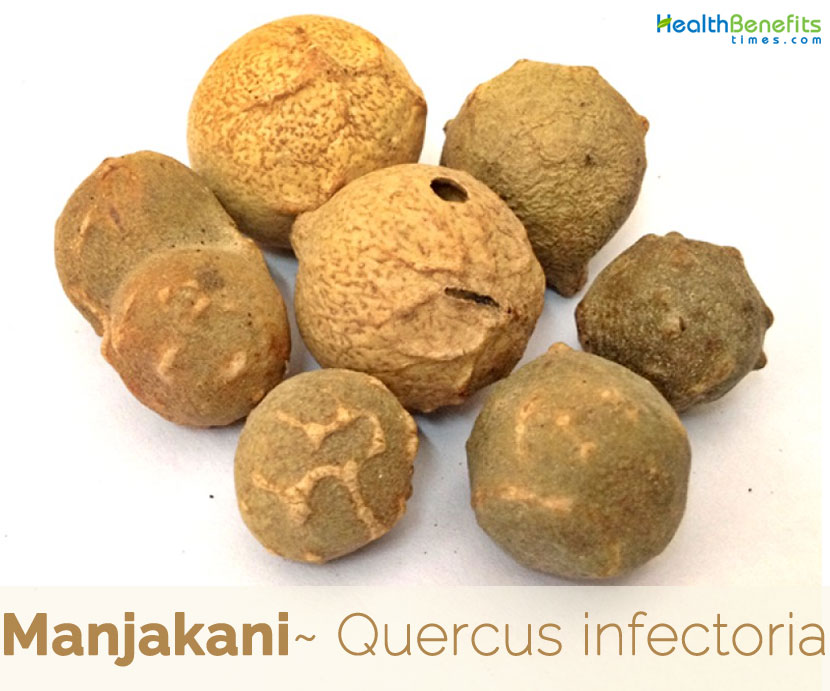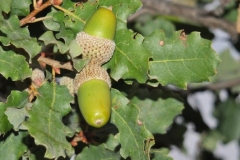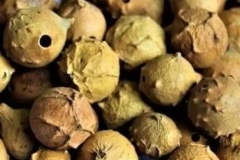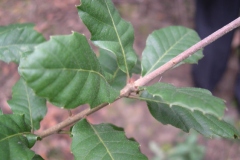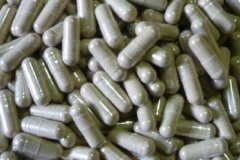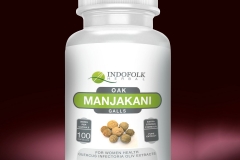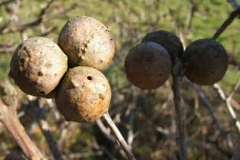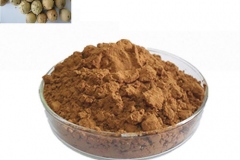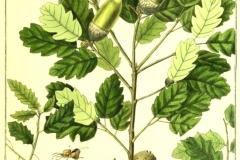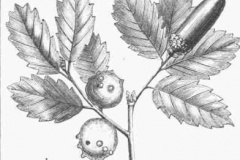| Manjakani Quick Facts | |
|---|---|
| Name: | Manjakani |
| Scientific Name: | Quercus infectoria |
| Origin | Southern Europe (Greece and the East Aegean Islands) and the Middle East |
| Colors | Black while ripening |
| Shapes | Smooth nut, called an acorn, mucronate, ovoid elongated, 2–3.5 cm long, 1.8 cm in diameter |
| Taste | Astringent, acrid, sour, pungent, bitter |
| Health benefits | Leucorrhea, Hyperpigmentation, Uterine and vaginal therapy, Piles, Inflamed gums, Rectal Prolapse in Children after Severe Diarrhea, Vaginal tightening, Nose bleeding, Teeth, Gums and Oral problems, Skin care Benefits, Sagging Breasts, Asthma and Diabetes Control, Ringworm and Alopecia Cure, Hiccups Remedy, Cures mouth ulcers, Mouth wash, Antiseptic wash, Urinary Infection, Bad Odors, Good for Post Pregnancy, Rectal Bleeding, Dental problems, Healing wounds |
| Name | Manjakani |
|---|---|
| Scientific Name | Quercus infectoria |
| Native | Southern Europe (Greece and the East Aegean Islands) and the Middle East (Turkey, Cyprus, Iran, Iraq, Lebanon, Syria and Israel). It also grows in South and Southwestern Asia |
| Common Names | Cyprus Oak, Downy Oak, Dyer’s Oak, Nut-Galls, Asian holly oak, Aleppo oak, Gall oak, Magin gall, Dyers’ Gall Magic Nut, cinnamon oak, bluejack oak, upland willow oak, sandjack oak, Mecca gall, Syrian gall, turkey gall, gall nut |
| Name in Other Languages | Arabic : Afas, Afss, Ballut Afssi, Mazu, Uffes, bilut sabghi (بلوط صبغي) Armenian: Arak’syan kaghni (արաքսյան կաղնի) Assamese : Aphsa Bengali: Majuphal, Majoophal Burma: Pinza-kanj si, Pyinthagar-ne-thi Czech : Dub Hálkovec Dutch : Eik Soort English: Asian holly oak, Aleppo oak, Gall oak, Magin gall, Dyers’ Gall Magic Nut, cinnamon oak, bluejack oak, upland willow oak, sandjack oak, Mecca gall, Syrian gall, turkey gall, gall nut Estonian : Tinditamm Finnish: Rieputammi French : Chêne À Galles, Chêne d’Alep, Chêne d’Israel, chêne du Kurdistan German : Gall-Eiche, Gallapfel-Eiche, Kurdistan, Kurdistan-Eiche Greek: Drys i vafikí (Δρυς η βαφική), drys vafikí (δρυς βαφική) Gujarati: Majuphal, Muajoophal, Mayfal, Maiphal Hebrew: אלון התולע Hindi: Majuphal (माजूफल), Majuphul, Mazu, Muphal, majoofal Hungarian : Kurdisztáni Tölgy Indonesia : Manjakani Italian: Quercia alle galle Kannada: Machikai, Macike, Machi Kaayi, Mapalakam Kurdish: Mazî Malayalam: Masikka, Mayakku , majkani, Majakaanee, Mashikkay Malaysia : Manjakani, Biji manjakani Marathi: Majuphala, Maayaphal Oriya: Mayakku Persian : Mazu, Maju, Mazu-E-Sabz, دار مازو Punjabi : Maju Russian: dub maloaziatskiy (дуб малоазиатский) Sanskrit: Ambastha, Majjaphala, Majuphal, Majuphul, Manjuphal, Mayakku, Mayaphala, Mayuka Siddha: Mochakai, Mashikkai Siryani: Aafsi Spanish : Encina De La Agalla, roble de Aleppo, roble tintoreto Swedish : Aleppoek Tamil: Cakkirakacikakkay, Cakkirakacikam, Civatakitakkay, Maasikkai, Macakkai, Macakkay, Macikkai, Macikkay, Machakai, Machikai, Machikkai, Maci, Masikkai, Mayakkay, Mayakkay Telegu: Mashi Kaaya, Mashikaya, Masikaya Thai : Ben Ka Nee Turkish : Mazı Meşesi Unani: Maaju phal, Maazu, Feetus, Falees, Maaphala, Iqaqualees Urdu: Baloot, Mazu, Mazu Sabz, Mazu Subz |
| Plant Growth Habit | Deciduous, semi-evergreen, small tree or shrub |
| Soil | Grows on a wide range of soil types from acidic to alkaline, in full to partial sun |
| Plant Size | One to two meters (four to six feet) in height |
| Root | Cylindrical, branched, and shows fibrous fracture, 6-10 cm long, and 4-8 mm in thickness |
| Bark | Slightly grey, scaly, ridged bark |
| Shoot | Pubescent, reddish or yellowish brown |
| Buds | Reddish-brown, about 3 mm and pubescent |
| Leaf | Alternate, very variable in size and color, 40–70(–100) by 10–45 mm, leathery, glabrescent, ovate to narrowly oblong, rounded or wedge-shaped at base |
| Flower | Flowers are unisexual. The male flowers are tangled into hanging, axillary catkins, with a 6-8 tepaled perigone and 6-10 stamens. The female sessile flowers are single or in small groups in the leaf axils of dropping stipules |
| Fruit Shape & Size | Smooth nut, called an acorn, mucronate, ovoid elongated, 2–3.5 cm long, 1.8 cm in diameter |
| Fruit Color | black while ripening |
| Gall | Galls are globular in shape about 10 to 25 mm in diameter. They have a short, basal stalk and numerous rounded projections on the surface |
| Gall Skin | Smooth, shining, bluish-green, olive green or white brown |
| Plant Parts Used | Fruit, bark, seed, leaf |
| Taste | Astringent, acrid, sour, pungent, bitter |
| Health Benefits |
|
Plant Description
Manjakani is a deciduous, semi-evergreen, small tree or shrub that normally grows about one to two meters (four to six feet) in height. The plant is found growing on a wide range of soil types from acidic to alkaline, in full to partial sun. Roots are cylindrical, branched, and show fibrous fracture, 6-10 cm long, and 4-8 mm in thickness. Shoots are pubescent, reddish or yellowish brown colored. Buds are reddish-brown, about 3 mm and pubescent. The plant has reddish-brown, about 3 mm and pubescent.
Leaves
Leaves are alternate, very variable in size and color, about 40–70 mm long and 10–45 mm wide, leathery, glabrescent, ovate to narrowly oblong, rounded or wedge-shaped at base. Margins are often wavy with 4–8 crenate to saw-toothed lobes, or entire (at base of twigs); primary veins 6–11. Petiole is 1–15mm long. Upper sides of the leaves are usually shiny.
Flowers
The flowers are unisexual. The male flowers are tangled into hanging, axillary catkins, with a 6-8 tepaled perigone and 6-10 stamens. The female sessile flowers are single or in small groups in the leaf axils of dropping stipules. The perigone is 6 tipped with an inferior 3 chambered ovary surrounded by an initially inconspicuous and then later cup shaped cupula.
Fruits
Fertile flowers are followed by smooth nut, called an acorn, mucronate, ovoid elongated, 2–3.5 cm long, 1.8 cm in diameter; glabrous, cylindrical, shiny brown and is more or less enclosed in a scaly involucre called the cup or cupule.
Galls
Galls are abnormal overgrowth / tumors caused by various parasites on host plant. There are more than 2,000 kinds of galls formed by wasps, flies, beetles, ants, moths, bacteria, and viruses. The parasite injects chemical in the plant that causes formation of galls. These over growths are used by the eggs and larvae as a house which provides food and shelter to growing insect. Galls are globular in shape about 10 to 25 mm in diameter. They have a short, basal stalk and numerous rounded projections on the surface. The galls are hard and heavy, usually sinking in water.
The so called blue variety is actually of a grey or brownish-grey color. These and to a lesser extent the olive-green ‘green’ galls, are favored to the ‘white’ variety, in which the tannin is said to have been partly decomposed. White galls also differ from the other grades in having a circular tunnel through which the insect has emerged. Galls without the opening have insect remains in the small central cavity. Galls have a very astringent taste. Sections through a gall show a very large outer zone of thin walled parenchyma, a ring of sclerenchymatous cells, and a small, inner zone of rather thick-walled parenchyma surrounding the central cavity. The parenchymatous tissues consists of abundant starch, masses of tannin, rosettes and prisms of calcium oxalate, and the rounded so-called ‘Lignin bodies’, which give a red color with 2 phloroglucinol and hydrochloric acid. Average weight of ten galls picked at random should not be less than 2.5 grams.
Health Benefits of Manjakani
Manjakani (Oak Galls) contributes to all its therapeutic benefits and uses. It is effective in wide range of diseases including dental problems, abdominal diseases, uterine disorders etc. Let us discuss the principle uses and health benefits of Manjakani.
1. Leucorrhea
When used internally Manjakani helps to control the symptoms of leucorrhea. Leucorrhea is actually a thick, whitish discharge from the female genitals. According to Ayurveda, leucorrhea is due to an imbalance of Kapha dosha. Majuphal shows a good result in leucorrhea because of its Kashaya (astringent) property. It helps to control aggravated Kapha and decrease the symptoms of leucorrhea.
2. Hyperpigmentation
Manjakani is useful to reduce the symptoms of hyperpigmentation. Hyperpigmentation is caused due to worsening of Pitta dosha in the body when the skin is exposed to heat or the sun. It helps in reducing tanning and pigmentation due to its healing property and cold nature.
3. Uterine and vaginal therapy
Manjakani together with other herbs are used as drinking remedies by women after childbirth to restore the elasticity of the uterine wall, and in many vaginal tightening products. Extract of manjakani was claimed by the Malay Kelantanese to be highly beneficial for postpartum women. Dangerous effects of the extract were not reported so far. Additionally, the Arabs, Persians, Indians, Malays and Chinese have traditionally used the galls after childbirth to treat vaginal discharge and related postpartum infections.
4. Piles
Piles are mainly caused by an unhealthy diet and sedentary lifestyle leading to constipation. This causes swelling in the veins of rectum area leading to piles mass. Majuphal gives relief in swelling of pile mass and also controls bleeding because of its astringent property. Majuphal also reduces burning sensation and discomfort in piles due to its cold nature. It gives cooling effects and reduces burning sensations in the anus.
5. Inflamed gums
Majuphal can be used to treat swollen, spongy and bleeding gums. It has an astringent property that decreases swelling and controls bleeding. It also produces a cooling and soothing effect on the gums due to its cold nature.
6. Rectal Prolapse in Children after Severe Diarrhea
Manjakani decoction should be used to wash the lower section of the large intestine. Cotton cloth is dipped in the Majuphal decoction and kept on the affected part. Manjakani powder paste can also be applied on the affected part.
7. Vaginal tightening
Take a liter of water in a pan and boil it. Pound 2 manjakani in a mortar and pestle and add to the boiling water. Let it boil till the color changes. Switch off, cool and strain and use it as a wash. Start using it immediately after the pregnancy along with kegel exercise for best results. Since Manjakani gel is very famous in Malaysia for tightening vaginal muscles, but this simple homemade wash is also very effective.
8. Nose bleeding
Nosebleed is a fairly common condition that can be controlled easily. There are actually two types of nosebleeds i.e. anterior or front and posterior or back nosebleed. Front nosebleed is fairly common and can be controlled using home based cures. Oak Gall is rich in blood-clotting agents and hence it can be used to treat or cease nosebleeds. Consult your doctor in case of posterior nosebleed because it’s not a common condition.
9. Teeth, Gums and Oral problems
Numerous oral or dental problems can be easily prevented and treated with Oak Gall and which is why top dental care companies include it in their products such as dental powders, herbal toothpastes, mouth washes and gargling solution. Oak Gall is useful in teeth strengthening, relieving gum problems and treating oral infections. Furthermore, it is also beneficial for treating bad breath, cavities and bleeding gums.
Its decoction can be used as a gargle to get rid of sore throat, throat infection, loose gums, tonsillitis, and many other oral issues. Just boil Oak Gall powder with water for few minutes. Strain it and use it as a mouth wash. Keep the left over solution in your fridge for two or three days.
Paste made by rubbing oak gall on stone is extremely beneficial for curing mouth ulcers. Apple the paste on the affected area daily until your ulcer disappears. This paste is quite safe and can be freely used for small kids as well.
10. Skin care Benefits
Oak gall helps in solving out variety of skin issues like skin infection, cuts, wounds, acne, large pores, excessive bleeding, eczema, impetigo, ringworm, saggy skin and so forth. Due to its great astringent effects, it is quite helpful in dealing with open pores and loose skin. Apply Oak Gall decoction on the skin to reduce pores size the natural way. This remedy will also help you achieve firm and smooth skin. It is also said to be effective in preventing acne and infections. Use this solution to wash your face daily to have clear and bright skin.
Anti-oxidants present in Oak Gall are helpful in dealing with premature ageing. The decoction can also be used to stave off greasy and dry skin. Boil oak gall powder with water. Strain it and use this healing, anti-fungal and anti-septic solution to wash or clean wounds and cuts. This remedy will speed up the wound healing process and prevent further infection.
11. Sagging Breasts
There are many causes of sagging or loose breast. Oak Gall or gall nut is fraught with tightening properties. All you need to do is to make a concoction of this herb and have it twice every week. This remedy will solve your problem without using costly creams and other medical treatments.
12. Asthma and Diabetes Control
Manjakani is loaded with expectorant properties and thus is can be used to treat asthma effectively. Gallic acid present in Oak Gall is effective in curing diabetes. Prepare Oak Gall tea and have it to relieve asthma and diabetes the natural way.
13. Ringworm and Alopecia Cure
In Unani medicine problems like ringworm and alopecia are treated by soaking oak gall in vinegar and applying the resultant remedy on the affected site.
14. Hiccups Remedy
Mix equal quantities of black pepper, camel thorn, long pepper, orris root, oak gall, nutmeg and ginger. Powder these ingredients and have half to one teaspoon of this powder with honey once every day. It is quite beneficial for curing hiccups.
15. Cures mouth ulcers
Manjakani are outstanding for treating ulcers inside the mouth. Manjakani has high astringent properties and it is this quality that heals mouth ulcers very quickly. Some people have small ulcers that are white in color on both sides of their mouth. This oak gall paste is a good remedy for that. This paste can be safely used for small children too. When you apply this paste, it has a slightly bitter and astringent taste. Try applying this paste for few days continuously, to get relief. To make this paste, soak oak gall in water for some time. This will make it easier to rub into a paste. Rub the oak gall on a sandalwood stone along with little water till you get a thick paste. Apply this paste on the affected area. You will be surprised, how quickly mouth ulcers heal with this remedy.
16. Mouth wash
Mouth wash made with oak gall helps to treat ulcers in the mouth effectively. Powder the manjakani in a mortar and pestle. Take around a tsp. of the powdered manjakani and boil it along with little water. Let the water come to lukewarm temperature and then use it as a mouth rinse. This mouth rinse will treat mouth odor, mouth ulcers effectively. The rest can also be stored in the refrigerator and used every day.
17. Antiseptic wash
When manjakani is boiled with water and used to wash wounds and scrapes, it heals them faster. It is much better than commercial brands like Dettol. It is considered best to wash the wound with this rinse, both morning and night for best results.
18. Urinary Infection
Manjakani helps to relieve urinary tract infections. Its astringent property helps overcome infection in urinary tracts, besides healing the damages in tissues, and rejuvenating skin and tissue health in the vagina. Its consumption internally is suggested along with other herbs to be effective, but its astringent property makes it the best solution for external cleaning to get rid of ulcers and tissue damages in any part of the body.
19. Bad Odors
Manjakani helps overcome bad odor from genital areas. Use of Manjakani extract solution for washing infected or smelling parts helps overcome foul smell originating from private parts in women, besides terminating bacteria or fungi residing in these areas.
20. Good for Post Pregnancy
Manjakani is highly beneficial for dealing with Post birth body. Sagging breasts, vaginal looseness are common conditions, which a mother experiences after birthing. Consuming Manjakani helps firm the sagging breasts and topical application to the vagina, used in conjunction with vaginal exercises, helps tighten vaginal tissues.
21. Rectal Bleeding
Oral consumption of Manjakani helps to get relief from rectal bleeding. As being anti-hemorrhagic it helps overcome rectal bleeding. Powdered form of oak gall is used in conjunction with other herbs such as dried ginger powder and mesua ferrea in sugar and clarified butter to be consumed twice daily for relief.
22. Dental problems
Numerous Indian herbal tooth powders and toothpastes use Manjakani as one of the key ingredients. Patanjali Dant Kanti toothpaste actually uses Manjakani as one of the main ingredients.
Powdered Manjakani when mixed in powdered forms of babul bark and neem in black salt and used as tooth powder for oral cleaning, helps overcome bleeding gums, pyorrhea, and other oral infection conditions. It is also used for improved oral hygiene in Children. Mouth ulcers in children are a common concern, and use of Manjakani, as a mouth wash, helps heal the ulcers fast. Toothpaste and toothpowders that has Manjakani is suggested for prolonged use to maintain total oral hygiene in children and adults.
23. Healing wounds
Manjakani is an excellent wound healer. The antiseptic property owing to its astringent characteristics helps heal wounds faster. Upon washing the wounds in a solution obtained from boiling oak gulls in water, the wounds heal faster besides avoiding secondary infections. It is safer than commercially available antiseptic lotions and creams.
Traditional uses and benefits of Manjakani
- Manjakani is reported to have a great medicinal value and had pharmacologically been reported to be astringent, anti-diabetic, anti-tremor, local anesthetic, antipyretic and anti-Parkinson and used in the treatment of intertrigo, impetigo and eczema hemorrhages, chronic diarrhea, dysentery, etc.
- In Asian countries, the galls have been used for centuries for treating inflammatory diseases.
- Gargle of hot water extract of galls was claimed to be very effective against aphthous sores and putrid sore throat.
- Direct application of boiled and bruised galls on skin was claimed to effectively cure any swelling or inflammation.
- Manjakani is widely known in Indian traditional medicine and have been used as dental powder and in the treatment of toothache and gingivitis.
- Manjakani was claimed to be highly beneficial for the Malay Kelantanese postpartum women preparation and was thought to help in revitalization and full recovery of the reproductive functions.
- Its astringent property was held to play a role in the restoring of health, to tone and increase vigor.
- The bark and acorns are astringent.
- They are used in the treatment of intertrigo, impetigo and eczema.
- Galls can be used in the treatment of hemorrhages, chronic diarrhea, dysentery etc.
- The Arabs, Persians, Indians, Malays and Chinese have traditionally used the galls after childbirth to treat vaginal discharge and related postpartum infections.
- Galls are considered as an astringent, acrid, cooling, haemostatic, constipating, vulnerary, expectorant, digestive, febrifuge, trichogenous and tonic.
- Powdered gall mixed with alum and tied in a muslin gauze used to be inserted into the vagina to help regression of prolapsed uterus.
- It is also used in the form of a vaginal douche to treat leucorrhoea, atonic menorrhagia and prolapsed of the uterus.
- An ointment applied in the vaginal canal was used to treat vaginal laxity.
- Decoction is used to treat diarrhea and dysentery per oral.
- There are also ointments prepared with powders of Oak galls incorporated into it as a local application for these anal diseases.
- For throat infection like tonsillitis and stomatitis effectively a gargle was prescribe made from decocting oak galls.
- Decoction of Q. infectoria gall is used as an antidote to various plants poisons especially those due to alkaloids eg. Opium, nux-vomica, aconite.
- It has been used to promote healing of wounds from cuts, skin infections.
- It also treats impetigo, eczema, hyperhidrosis and chapped nipples.
- Ringworm and alopecia was treated by Unani physicians by making use of oak gall soaked in vinegar.
- It is taken internally to treat conditions such as acute diarrhea, dysentery and hemorrhages.
- Extracts of the plant can be added to ointments and used for the healing of cuts.
- Gargling with Manjakani decoction reduces inflammation of the throat and manages tonsillitis.
- It also prevents bleeding in gum.
- Manjakani might be used in certain vaginal problems as candida infections due to its antifungal property.
- In Ayurveda, Galls are used in the treatment of Piles, Diarrhea, Small Intestine Disease, Oral Diseases, Dysentery, Dental Disorders, Vaginal Tumor and Leucorrhoea.
- It is used as an ingredient in dental formulation (such as Gum Tone Charak) for treating gum problems, strengthening gums, and teeth.
- It reshapes vaginal walls.
- It alleviates Leucorrhea symptoms.
- It prevents Uterine Prolapse.
- It sanitizes the female sex organs and protects them from vaginal bacterial and fungal Infections.
- It increases sensitivity, and consequently increases sexual pleasure.
- It enhances the production of Hormone Estrogen.
- It also tightens the Breast Muscles and is good for saggy Breast.
Ayurvedic Health benefits
- Anal fissure, vaginal laxity, anus prolapse, piles: Finely powdered gall (1 part), and Vaseline (4-6 parts) are mixed, and applied topically.
- Chronic diarrhea: In chronic diarrhea, 1 gram of powdered gall is taken, thrice daily with little cinnamon powder. In advanced stage, the decoction is given in a dose of 30-60 ml, thrice daily.
- Gonorrhea: The powder of gall is taken 2-3 times a day in a dose of 1-2 grams.
- Leucorrhoea: Decoction of galls is used to wash the vaginal area.
- Oral problems, nasal catarrh, sore throat: Due to high tannic acid content, the decoction / infusion is used as gargle in oral problems.
- Poisoning: Once the stomach is emptied, the decoction of galls is given in a dose of 50-100 ml.
- Piles, dysentery, and diarrhea: Dry powder is taken in a dose of 500mg to 1 gram with honey.
- Prolapse of rectum: The decoction of galls is used as an enema. OR keep a pad soaked in decoction on anal area. For making decoction, boil 5-10 grams of bruised galls in half liter water for 10-15 minutes.
- Sore throat, Tonsils: Gargle with decoction of galls added with alum.
- Swelling: The galls are boiled, crushed, and applied externally on the affected body part.
- Wounds: The gall powder is dusted on wounds
- Breast Diseases: Make a concoction of Manjakani. Drink twice a week.
- Wounds: Prepare a decoction of the bark of Manjakani. Drink three times a day. OR: Take l-2ml of the tincture three times a day.
- Loose Vagina: Take Manjakani, crush and boil it in water. When the color of the water changes, leave it to cool. Use the cooled water to wash the vagina and experience the result yourself.
- Aphthous Ulcers: Take Manjakani and prepare a paste out of it. Apply, it directly on the infected area for a complete cure.
- Caries: Put 30 to 40 grams powder of Manjakani, and boil it in the water. Let it cool. Use this lukewarm water as a mouth wash for once a day in the morning. It helps to remove Caries and bad odor from mouth.
- Antiseptic: Boil Manjakani in water. Try to wash out your wounds and cuts with this water. It helps to heal them faster.
- Breast Cancer: Take 1 to 2 teaspoon powder of Manjakani and pour it into a glass of boiled water. Cool and filter, drink it twice a day.
- Diabetes: Take Manjakani and prepare a tea with it. Drink it for once a day.
- Cervical Cancer: Boil Manjakani in water. Drink it twice a day.
- Vaginal Care: For internal medication take Dong Quai, Pueraria Mirifica, Betel Leaf and Carambola together and Manjakani. For local application Use decoction of Betal leaves and or Manjakani.
- (From Betal Leaves: Boil Macerated Betel leaves. Reduce heat to simmer for 10 minutes. Cool till warm. Dip tampon in liquid. Insert in Vagina. Keep it there for 15 minutes. Remove. Repeat daily for one week. )
- (From Manjakani: Coarsely powder Manjakani balls. Boil about 50 gm. of Manjakani in one liter of water. Reduce heat and simmer till water is half. Cool. Dip a tampon in the liquid. Insert in Vagina. Keep it there for 15 minutes. Remove. Repeat daily for one week. )
- Hiccups: Take equal amount of dried form of Camel Thorn, Ginger, Black Pepper, Long Pepper, Nutmeg, Manjakani and Orris Root. Put them in a grinder together. Powder them. Have a teaspoon powder with Honey once a day.
Culinary Uses
- Seed can be thoroughly washed in running water to remove the bitter tannins and cooked.
- Seeds can be dried, ground into a powder and used as a thickening in stews etc. or mixed with cereals for making bread.
- When roasted the seeds can be used as a coffee substitute.
- The nut gall extract or powder is used as an herbal drink or tea for health purposes.
How to Use Manjakani
Manjakani Powder
- Take 1-1.5gm of Manjakani powder or as directed by the physician.
- With lukewarm water and have it once or twice a day to get rid of the symptoms of leucorrhea.
Majuphal Kada (Decoction)
- Take 1-3 gm. of Manjakani powder.
- Mix it with 2 cups of water.
- This mixture is then boiled 10 to 15 minutes or until it becomes ¼ cup of water.
- Filter this one-fourth cup of decoction.
- Take this lukewarm decoction 5-10 ml twice a day or as directed by the physician.
Other facts
- Tree is occasionally cultivated for production of tanning bark and for dye production of the wood.
- An extract from the tannin-rich gallnut is mixed with ferrous sulphate together with a gum and coloring in order to make an ink.
- Gallnuts are also used to make a black dye besides providing a rich source of tannin and gallic acids.
- Ink is made from the tannin-rich galls.
- These have been used for centuries in softening leather and in making black dye and ink.
- The tree is suitable for reforestation projects.
Precautions
- Galls are high in Tannins. In large doses, tannic acid can cause stomach irritation, nausea, vomiting, and the liver damage.
- It is better to avoid use of Oak gall during pregnancy, it may lead to miscarriage.
- Do not use if suffering from kidney or the liver disorders.
- Do not use continuously or in the high quantities.
- It can reduce the effectiveness of digestive enzymes.
- It affects absorption of iron.
- It causes constipation.
- Avoid taking Manjakani during Menses.
References:
https://www.itis.gov/servlet/SingleRpt/SingleRpt?search_topic=TSN&search_value=506537#null
https://pfaf.org/user/Plant.aspx?LatinName=Quercus+infectoria
https://www.cabi.org/isc/datasheet/46485
https://npgsweb.ars-grin.gov/gringlobal/taxonomydetail.aspx?30697
https://www.wikidata.org/wiki/Q3565069
https://gd.eppo.int/taxon/QUEIT
http://www.theplantlist.org/tpl/record/kew-173331
https://en.wikipedia.org/wiki/Quercus_infectoria
https://plants.usda.gov/core/profile?symbol=QUIN6
http://temperate.theferns.info/plant/Quercus+infectoria
https://www.wikizero.com/en/Quercus_infectoria


